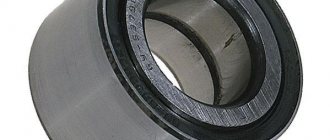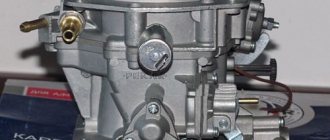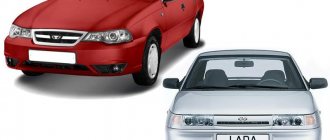VAZ-2108 “Sputnik”
(export name -
Lada Samara
; nicknames - “Eight”, “Chisel”) - Soviet and Russian front-wheel drive car of group II small class with a hatchback body.
Developed and mass-produced at the Volzhsky Automobile Plant in 1984-2003. It was the base model in the Lada Sputnik family of models. Since 2004, the car has been replaced on the assembly line by the VAZ-2113 model.
Development of a front-wheel drive system
It was the first front-wheel drive VAZ, and its engine was located transversely. It operated on the principle of a sequential circuit, where the axes of the crankshaft and input shaft from the manual transmission were located side by side and rotated in the same direction. A 1-liter power unit was installed in the car, and its power was 45 horses. At that time, the VAZ 2108 was a technical leap forward for the Soviet automobile industry, because it used then-current parts, such as MacPherson strut suspension and Hooke joints. Despite the very successful development, this was only the first prototype and the engineers had an idea to modernize the car.
VAZ 2108 The history of the second prototype model began in 1973, when it was manufactured. The factory decided to test the system components and engine of this model to see how efficiently they work. For this purpose, special scooters were used; they were a car body into which you could simply install an engine with the necessary components and start it.
To launch a front-wheel drive car into mass production, the Volga plant had to enter into an agreement with the Hardy-Spicer company from England. VAZ bought from them the technology for producing a new type of hinges, which were used on the 2121 model, and later on the iconic 2108.
Before starting the full production of the model, the engineers decided to test foreign cars of those years that had front-wheel drive. Based on the results of these tests, it was revealed that in the conditions of Russian roads, all foreign cars had one weakness - the chassis. They immediately began to adjust the suspension and control of the prototype; by the way, at the time of testing it had an engine from FIAT model 128 installed.
Taking into account the weaknesses found in foreign cars, the last prototype was made, which in appearance was very similar to the serial VAZ 2108, and this happened in 1977. As a result, in May of the same year, engineers implemented the experience gained into a demonstration model of the VAZ 2108.
To balance the engine and chassis for optimal driving, two variants of the model were produced, marked "W" and "D". The car marked with the letter “Ш” was a body from a penny with system components and an engine from the serial VAZ 2108. Cars with a body from 2106 and an engine from 2108 were marked with the letter “D”, respectively.
Having considered all the developments of the engineers, the Ministry of Automotive Industry issued a decree to produce the VAZ 2108 model equipped with a 1.3-liter engine, and the length of the car should be approximately 4 meters.
Test
Impudent fellow
This domestic “front-wheel drive” still looks defiant and aggressive. Attention is drawn to the rapid profile of the body with a pointed front part (for this reason, the 2108 received the popular nickname “chisel”), a low roof, a taut rear, and long side doors. The headlight optics are combined into monoblocks, and the bumpers are made of impact-resistant plastic.
The advantage is simplicity
Compared to the classic Zhiguli family, the G8's interior is less luxurious and more ascetic. However, the ergonomics of the 2108 are an order of magnitude higher - the main controls are located in close proximity to the driver, and the small steering wheel with a plump rim has a comfortable grip.
The instrument panel with a minimum of information is easy to read. Its backlight is regulated by a rotating toggle switch, which is located on the left, on the body of the “toolbox”. As for the center console, there is a socket for installing a radio at the top, while the air conditioning unit is located under the cigarette lighter.
Implementation of knowledge of foreign engineers
This was done with the aim that the authorities were going to distribute this car model not only in the Union, but also export it to European countries. Europe had already become saturated with conventional front-wheel drive cars, which meant they needed to deliver a product that could surprise. To finalize the engine and chassis, Soviet engineers turned to Porsche specialists for help. Thus, foreign engineers also had a hand in the history of the VAZ 2108.
Foreign engineers found several flaws in the VAZ 2108 designs and made their own adjustments. Thanks to their intervention, cars were equipped with Solex carburetors, which were new at that time. And in the rear part of the car body they made a small hump so that while driving the car would be pressed harder to the ground. The vehicle's stability, handling and dynamics have also been improved. As for the appearance of the VAZ 2108, this is the merit of the designers from Tolyatti, who decided to use the trends of the canons of the Italian automobile industry in their work.
Taking into account the assistance of foreign engineers in the creation, the first VAZ 2108 had a set of most Western parts. And this is glass from Sweden, French tires, etc. Thanks to these introductions, the car was competitive in the European market. The emphasis in the first cars was on safety and high ergonomics.
DESIGN DESCRIPTION
BODY
The VAZ-2108 body has a three-door all-metal welded load-bearing structure. The car has both passenger and cargo-passenger body options. All parts and components of the body, except for the hinged ones, form a single whole, welded by resistance spot welding, and heavily loaded parts are additionally welded by electric arc welding. The main body parts are stamped from low-carbon steel sheets. The thickness of the main body parts is 0.8 mm, the outer panels of the doors and front wings are 0.7 mm, and the thickness of the reinforcements is 1-1.2 mm. Small parts are stamped from steel with a thickness of 0.8-2.5 mm.
ENGINE AND GEARBOX
The car is equipped with a four-cylinder, four-stroke carburetor or injection engine with a cylinder capacity of 1100 cm3, 1300 cm3, or 1500 cm3 (depending on the modification) with an in-line arrangement of cylinders and a camshaft located on the cylinder head. The engine is specifically designed for transverse mounting in a front-wheel drive vehicle. The engine combined with the gearbox and clutch form the power unit. It is installed on the vehicle on three elastic supports.
Depending on the vehicle configuration, a four- or five-speed gearbox is installed. Structurally, the gearbox is combined with the main gear and differential. Torque from the gearbox is transmitted to the drive wheels through the front wheel drive.
FRONT SUSPENSION
The car is equipped with a "swinging candle" or MacPherson type suspension
REAR SUSPENSION
The car has a torsion bar suspension for the rear wheels. The suspension guiding device is two longitudinal arms connected to each other by an elastic connector. The independence of the movement of each wheel is ensured by twisting the amplifier, which has a U-shaped cross-section, which has high bending rigidity and low torsional rigidity.
The rear suspension shock absorber is hydraulic telescopic, double-acting. The elastic elements of the suspension consist of a spring and a compression stroke buffer. The spring is made of spring steel of round section. It is installed on the shock absorber. The springs of the rear suspension, as well as the front, under a control load along the length are divided into two classes - A and B. Springs of class A are marked with yellow paint on the outside of the middle coils, class B - green.
STEERING GEAR
The vehicle is equipped with a rack-and-pinion steering mechanism.
BRAKE SYSTEM
The front brake mechanism is open disc. The rear one is drum-type, with automatic adjustment of the gap between the shoes and the drum.
ELECTRICAL EQUIPMENT
The VAZ-2108 uses a single-wire connection diagram - one wire comes from the energy source, and the role of the second is played by the mass of the car.
The VAZ-21083 modification is equipped with a microprocessor engine control system.
Latest prototype models
A sample of the car, which was to be exported to Europe, underwent very stringent tests. In a short period of time, the car traveled about 80,000 km, and this made it possible to find the weak points of the model and correct them.
Towards the end of 1981, a version of the car appeared, the so-called “two hundredth”. It was tested even more seriously, because this car was supposed to be distributed throughout the Union. The tests took place in harsh climatic conditions, sometimes in the Caucasus, sometimes in Turkmenistan, sometimes in the far north.
The “three hundredth” model rolled off the production line in 1983; this car was practically a copy of what you can see on the streets of the country.
Serial VAZ 2108 and modifications
The first production car was produced in 1984, December 19 to be precise. But mass production and the arrival of the car on the market happened only a year later.
VAZ did not have a grandiose debut. The fact is that it was almost impossible to find spare parts for the VAZ 2108, then there was a total shortage, and a very unreliable part was found in the model - the switch. The interior was lined with plastic, which did not create any sound insulation at all, but was also noisy. These nuances dealt a blow to the reputation of the new product. However, a few years later, when these problems were corrected and spare parts were already supplied to stores, Soviet car enthusiasts appreciated the superiority of the VAZ 2108 over other cars.
As a result of constant improvements, the eight was produced with engines ranging from 1.1 to 1.5 liters. Many modifications were released, so you can find the 2108 with right-hand drive, a 16-valve power unit, and even in a convertible body.
Production of this model ceased in October 2003, but since the car was ultimately very successful and sales were high, it was put back into production a few years later. Only this time the model was again slightly changed and given a new marking 2113. This was the history of the creation of the VAZ 2108. The video will show you all the modifications of this car.
DESIGN
EXTERIOR
Initially, the car was produced with a so-called “short” front wing, but this turned out to be impractical, since the plastic trim on the front end quickly “moved away” from the wings and became deformed from exposure to the sun. Starting in 1991, a new front end design was developed, with fenders and a hood of increased length. In addition, the false radiator grille has changed, which gives the car a more modern look (facelift).
INTERIOR
From the beginning of production, the car was equipped with a “low” instrument panel. Since 1991, the VAZ-2108 began to install a “high” instrument panel, which was distinguished by the presence of a tachometer and the absence of a voltmeter, as well as modified ergonomics.











